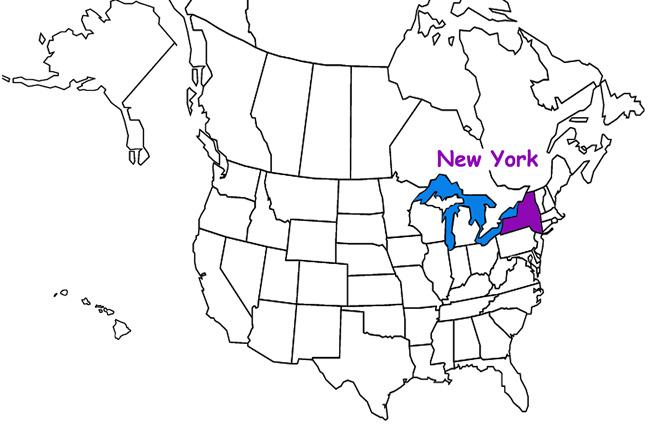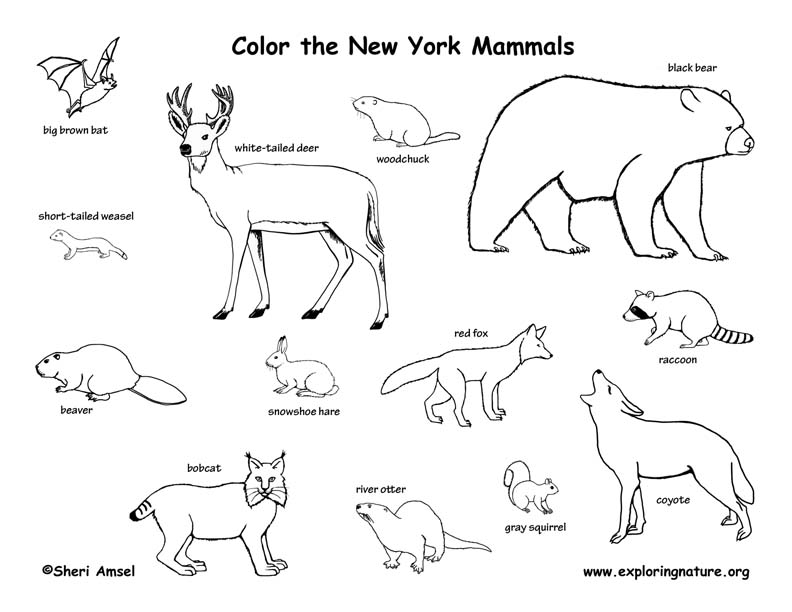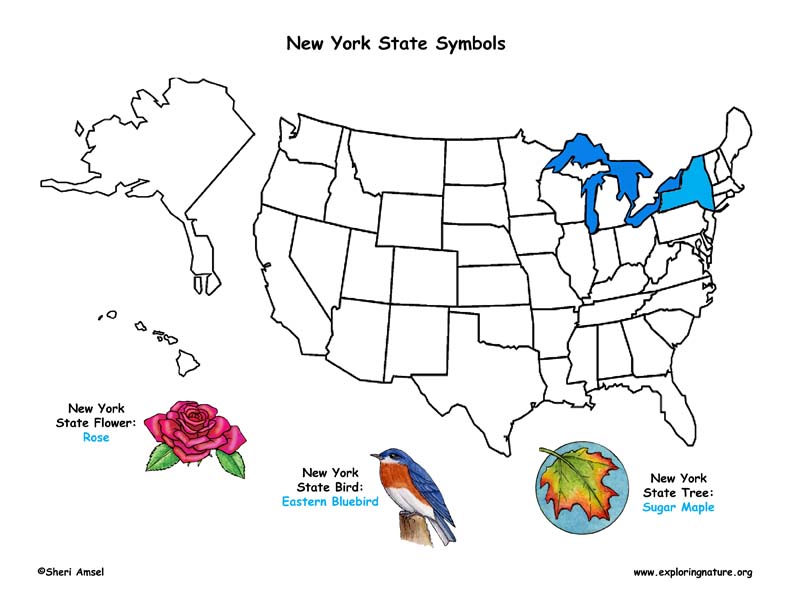


New York Habitats
New York is a large and diverse state. It has about 7,700,000 acres of farmland, 58,000 acres of barren land, 304,000 acres of commercial and industrial land, 240,000 acres of parks, golf courses and lawns, 1,532,000 acres of homes, 994,000 acres of waterways (70,000 miles of rivers and streams) and 902,000 acres of wetlands. It has more than 7,600 freshwater lakes, ponds and reservoirs including the Finger Lakes of central New York. New York borders two of the five Great Lakes – Lake Ontario and Lake Erie plus Lake Champlain which it shares with Vermont.
New York State has many distinct ecological regions called ecoregions. An ecoregion is a large area that has common climate, land forms and waterways that support a certain cross section (biodiversity) of plants and animals and is different from other ecoregions. There are 7 ecoregions in NYS (as used in the NY Comprehensive Wildlife Conservation Strategy (CWCS)).
1. The Great Lakes Ecoregion has low elevation, gently rolling hills and flat lake plains. This area of western NY is affected by the Great Lakes weather patterns and has great biodiversity and unique habitats.
2. The High Allegheny Plateau Ecoregion has high elevation hills forming a plateau rising up to 2,100 feet. It stretches from the Great Lakes Plains of Lake Ontario to the ridge and valley region of the Central Appalachians to the south, and from the Lake Erie Plain in the west to the Hudson River Valley.
3. The Lower New England - Northern Piedmont Ecoregion is a limestone valley of low mountains and lakes that are found along the mid- to southeastern portion of New York.
4. The North Atlantic Coast Ecoregion includes marine (ocean), estuaries and coastal areas. The area on Long Island and Staten Island has grasslands, shrublands, pine barrens, coastal plain ponds and dunes and salt marshes.
5. The Northern Appalachian - Boreal Forest Ecoregion has forest communities, large-scale wetlands and remote pond habitats. It covers a large portion of northern New York, most of the Adirondacks and Tug Hill Plateau.
6. The St. Lawrence - Champlain Valley Ecoregion has mountain streams, deltas and marshes that line the shores of the St. Lawrence River and Lake Champlain.
7. The Western Allegheny Plateau Ecoregion includes glaciated low, rounded hills, and wetlands and the unglaciated, hilly Allegheny Mountain at the southwestern-most end of the state.
The Adirondack Park, in northeastern New York, is the largest land protected "park" in the lower 48 states covering more that 6 million acres – an area greater than the Grand Canyon, Yellowstone, Glacier and Great Smoky Mountains National Parks put together. It differs from our National Parks in that over half of the area is privately owned. It contains the tallest mountain in NYS - Mount Marcy at 5,344 feet and a diversity of habitats including swamps, bogs, deciduous, coniferous and mixed forests, alpine summits, meadow/farmland, and lake, pond, river and stream habitats.
bat (big brown)
bat (eastern red)
bat (hoary)
bat (Indiana) - endangered
bat (eastern pipistrelle)
bat (Keen's)
bat (little brown)
bat (silver-haired)
bat (small-footed)
bear (black)
beaver (American)
bobcat
chipmunk (eastern)
coyote
deer (white-tailed)
fisher
fox (gray)
fox (red)
hare (snowshoe)
lemming (northern bog)
lemming (southern bog)
lynx (Canadian)
marten (American)
mink
mole (eastern)
mole (hairy-tailed)
mole (star-nosed)
moose
mountain lion - endangered
mouse (deer)
mouse (house)
mouse (meadow jumping)
mouse (white-footed)
mouse (woodland jumping)
muskrat
opossum (North American)
otter (river)
porcupine
rabbit (eastern cottontail)
rabbit (New England cottontail)
raccoon
rat (black)
rat (Norway)
shrew (least)
shrew (long-tailed)
shrew (masked)
shrew (northern short-tailed)
shrew (pygmy)
shrew (smoky)
shrew (water)
skunk (striped)
squirrel (eastern gray)
squirrel (fox)
squirrel (northern flying)
squirrel (southern flying)
squirrel (red)
vole (meadow)
vole (rock)
vole (southern red-backed)
vole (woodland)
weasel (long-tailed)
weasel (short-tailed or ermine)
wolf (gray) - endangered
woodrat (eastern) - endangered
woodchuck
Coastal Mammals:
dolphin (Atlantic white-sided)
dolphin (bottlenosed)
dolphin (grampus)
dolphin (saddleback)
dolphin (spotted)
dolphin (striped)
porpoise (harbor)
seal (gray)
seal (harbor)
whale (Atlantic beaked)
whale (Atlantic pilot)
whale (beluga)
whale (blue) - endangered
whale (fin) - endangered
whale (Gervais beaked)
whale (goose-beaked)
whale (humpback)
whale (minke)
whale (pygmy sperm)
whale (right) - endangered
whale (sei) - endangered
whale (sperm) - endangered
whale (True's beaked)
Amphibians
bullfrog (American)
Hellbender
frog (mink)
frog (northern green)
frog (northern cricket)
frog (northern leopard)
frog (pickerel)
frog (southern leopard)
frog (western chorus)
frog (wood)
mudpuppy (common)
newt (eastern red spotted)
salamander (Allegheny Mountain Dusky)
salamander (blue-spotted)
salamander (eastern tiger)
salamander (four-toed)
salamander (Jefferson)
salamander (long-tailed)
salamander (marbled)
salamander (northern dusky)
salamander (northern slimy)
salamander (northern spring)
salamander (northern two-lined)
salamander (red)
salamander (spotted)
salamander (spring)
salamander (Wehrle's)
spadefoot (eastern)
spring peeper
toad (American)
toad (Fowler's)
treefrog (gray)
Reptiles
lizard (common five-lined skink)
lizard (Italian wall)
lizard (northern coal skink)
lizard (northern fence)
rattlesnake (timber)
snake (common watersnake)
snake (common ribbon)
snake (eastern gartersnake)
snake (eastern hog-nosed)
snake (eastern ratsnake)
snake (eastern Massasauga)
snake (eastern milk)
snake (eastern wormsnake)
snake (northern black racer)
snake (northern brown)
snake (northern copperhead)
snake (northern red-billied)
snake (northern ring-necked)
snake (Queensnake)
snake (short-headed gartersnake)
snake (smooth greensnake)
turtle (Blanding's)
turtle (bog) - threatened, endangered
turtle (eastern box)
turtle (eastern mud)
turtle (eastern musk)
turtle (eastern spiny soft-shell)
turtle (painted)
turtle (snapping)
turtle (spotted)
turtle (wood) - endangered
Coastal NY Reptiles
sea turtle (green)
sea turtle (Kemp's Ridley)
sea turtle (leatherback)
sea turtle (loggerhead)
There are roughly 475 bird species be found in New York State. Birds often seasonally change locations so can be in one location for breeding, another for wintering, and others while migrating. They can also have been introduced or extirpated - which means no longer occurring in that area, but still existing in other locations. What follows is a bird list for New York State. There are live links for the birds that have detail pages – with latin name, natural history information and an illustrated diagram.
bittern (American)
bittern (least)
blackbird (brewers)
blackbird (red-winged)
blackbird (rusty)
bluebird (Eastern)
bobolink
bobwhite (northern)
bunting (indigo)
cardinal (northern)
catbird (gray)
chat (yellow-breasted)
chickadee (black-capped)
chickadee (boreal)
chuck-will's-widow
coot (American)
cormorant (double-crested)
cowbird (brown-headed)
creeper (brown)
crossbill (red)
crossbill (white-winged)
crow (American)
crow (fish)
cuckoo (black-billed)
cuckoo (yellow-billed)
dickcissel
dove (rock)
dove (mourning)
duck (American black)
duck (American wigeon)
duck (blue-winged teal)
duck (bufflehead)
duck (canvasback)
duck (cinnamon teal)
duck (common goldeneye)
duck (Eurasian wigeon)
duck (gadwall)
duck (green-winged teal)
duck (lesser scaup)
duck (mallard)
duck (northern pintail)
duck (northern shoveler)
duck (redhead)
duck (ring-necked)
duck (ruddy)
duck (wood)
eagle (bald)
eagle (golden)
egret (cattle)
egret (great)
egret (snowy)
falcon (peregrine)
finch (house)
finch (purple)
flicker (northern)
flycatcher (Acadian)
flycatcher (alder)
flycatcher (great-crested)
flycatcher (olive-sided)
flycatcher (willow)
flycatcher (yellow-bellied)
gnatcatcher (blue-gray)
goldeneye (common)
goldfinch (American)
goose (Canada)
grackle (common)
grèbe (eared)
grèbe (horned)
grèbe (pied-billed)
grèbe (red-necked)
grosbeak (blue)
grosbeak (evening)
grosbeak (rose-breasted)
grouse (ruffed)
grouse (spruce)
gull (Caspian)
gull (great black-backed)
gull (gull-billed)
gull (herring)
gull (laughing)
gull (ring-billed)
harrier (northern)
hawk (broad-winged)
hawk (Cooper's)
hawk (northern goshawk)
hawk (red-shouldered)
hawk (red-tailed)
hawk (sharp-shinned)
heron (great blue)
heron (green)
heron (little blue)
heron (tri-colored)
heron (black-crowned night)
heron (yellow-crowned night)
horned lark
hummingbird (ruby-throated)
ibis (glossy)
jay (blue)
jay (gray)
junco (dark-eyed)
kestrel (American)
killdeer
kingbird (eastern)
kingfisher (belted)
kinglet (golden-crowned)
kinglet (ruby-crowned)
loon (common)
loon (red-throated)
martin (purple)
meadowlark (eastern)
meadowlark (western)
merlin
merganser (common)
merganser (hooded)
merganser (red-breasted)
mockingbird (northern)
moorhen (common)
nighthawk (common)
nuthatch (red-breasted)
nuthatch (white-breasted)
oriole (Baltimore)
oriole (orchard)
osprey
ovenbird
owl (barn)
owl (barred)
owl (great horned)
owl (eastern screech)
owl (long-eared)
owl (short-eared)
partridge (gray) - introduced
partridge (ring-necked) - introduced
parula (northern)
pewee (eastern wood)
phalarope (Wilson's)
pheasant (ring-necked)
phoebe (eastern)
pine siskin
plover (piping)
rail (black)
rail (clapper)
rail (king)
rail (Virginia)
raven (common)
redstart (American)
robin (American)
sandpiper (spotted)
sandpiper (upland)
sapsucker (yellow-bellied)
shrike (loggerhead)
skimmer (black)
sky lark
sora
snipe (common)
sparrow (chipping)
sparrow (clay-colored)
sparrow (field)
sparrow (fox)
sparrow (grasshopper)
sparrow (Henslow's)
sparrow (house)
sparrow (Lincoln's)
sparrow (saltmarsh sharp-tailed)
sparrow (Savannah)
sparrow (swamp)
sparrow (song)
sparrow (seaside)
sparrow (white-throated)
sparrow (vesper)
starling
swallow (bank)
swallow (barn)
swallow (cliff)
swallow (northern rough-winged)
swallow (tree)
swan (mute)
swift (chimney)
tanager (scarlet)
tern (black)
tern (common)
tern (forester's)
tern (least)
tern (roseate)
tern (white-winged)
thrasher (brown)
thrush (Bicknell's)
thrush (hermit)
thrush (Swainson's)
thrush (wood)
titmouse (tufted)
towhee (eastern)
turkey (wild)
veery
vireo (blue-headed)
vireo (Philadelphia)
vireo (red-eyed)
vireo (warbling)
vireo (white-eyed)
vireo (yellow-throated)
vulture (black)
vulture (turkey)
warbler (bay-breasted)
warbler (black and white)
warbler (blackburnian)
warbler (blackpoll)
warbler (black-throated)
warbler (black-throated blue)
warbler (black-throated green)
warbler (blue-winged)
warbler (Canada)
warbler (Cape May)
warbler (Cerulean)
warbler (chestnut-sided)
warbler (golden-winged)
warbler (hooded)
warbler (Kentucky)
warbler (magnolia)
warbler (mourning)
warbler (Nashville)
warbler (palm)
warbler (pine)
warbler (prairie)
warbler (prothonotary)
warbler (Tennessee)
warbler (Wilson's)
warbler (worm-eating)
warbler (yellow)
warbler (yellow-rumped)
warbler (yellow-throated)
waterthrush (Louisiana)
waterthrush (northern)
waxwing (cedar)
whip-poor-will (eastern)
woodcock (American)
woodpecker (black-backed)
woodpecker (downy)
woodpecker (hairy)
woodpecker (pileated)
woodpecker (red-bellied)
woodpecker (red-headed)
woodpecker (three-toed)
wren (Bewick's)
wren (Carolina)
wren (house)
wren (marsh)
wren (sedge)
wren (winter)
yellowthroat (common)
When you research information you must cite the reference. Citing for websites is different from citing from books, magazines and periodicals. The style of citing shown here is from the MLA Style Citations (Modern Language Association).
When citing a WEBSITE the general format is as follows.
Author Last Name, First Name(s). "Title: Subtitle of Part of Web Page, if appropriate." Title: Subtitle: Section of Page if appropriate. Sponsoring/Publishing Agency, If Given. Additional significant descriptive information. Date of Electronic Publication or other Date, such as Last Updated. Day Month Year of access < URL >.
Amsel, Sheri. "New York Habitats, Mammals, Birds, Amphibians, Reptiles" Exploring Nature Educational Resource ©2005-2024. December 13, 2024
< http://www.exploringnature.org/db/view/New-York-Habitats-Mammals-Birds-Amphibians-Reptiles >







